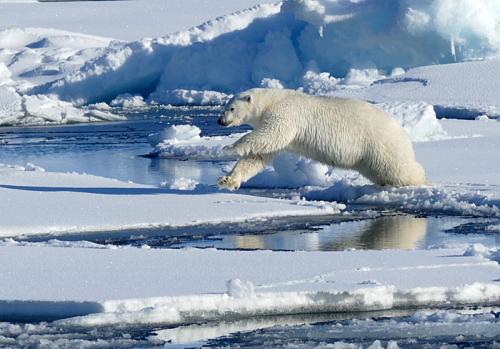
TODAY’S JOURNAL:
One aspect of the expedition that I particularly enjoyed was looking for polar wildlife. I was pretty busy most days with my PolarTREC duties but tried to carve out at least an hour each day to soak in the scenery and watch for wildlife. As we got farther and farther north sightings of living things off the ship grew more and more rare but there was always a possibility of picking up another sighting. The day before we arrived at the North Pole (4 September), we crossed polar bear tracks at 88.63°N, 179.88°E, and a bearded seal made an appearance in an open lead while we were on a water sampling station just a mile from the North Pole.
One of the most pleasing wildlife sightings for me came as we were crossing the shallow Chukchi Sea north of the Bering Strait. While we weren’t in pack ice yet, we entered a band of drifting ice floes. I was walking forward along the starboard side when I noticed dark shapes on some of the distant floes. As we got closer and I inspected the forms with binoculars I realized that they were walruses! This was the first time I had ever seen these magnificent giant seals and turned out to be the only walruses we would see on the expedition:
Almost any person I talk to about the expedition asks if we saw any polar bears. I’m happy to report that we saw 4 ice bears on our trip, all of which appeared to be healthy (in some cases downright plump) adults. I had the good fortune to see polar bears on my 2010 PolarTREC expedition, but one bear that we saw on my recent trip topped them all. We were stopped on a water sampling station over the Mendeleev Rise when a polar bear was spotted several kilometers away. While we continued to sample the bear wandered over to see what was going on. It ended up as close as perhaps 30 meters away, in brilliant sunlight. Polar bear experts later weighed in that this is likely a pregnant female- you’ll see how big her belly looks. As I write this she has probably moved into a den for the winter, where her cub (or cubs- twins are common) will be born.
Polar bears out on the pack ice primarily hunt for seals, and so Arctic seals tend to be pretty wary. If you’ve followed any Antarctic PolarTREC teachers you perhaps have seen how confiding southern seals can be- they aren’t worried about predators up on the ice (though in the water leopard seals and orcas are legitimate cause for concern.) But seeing Arctic seals is difficult- they don’t like to stay exposed out on the ice when something big like the Healy is coming. We saw a few, usually pretty far away, looking at us from open leads. I saw three other seals from very long distances on the ice but before we got even a kilometer away they dove in for safety. With this in mind, I was incredibly lucky to get footage of a ringed seal as it swam under the ice during one of our ice stations. I filmed under-ice scenes with my GoPro- usually I clamped it to a long aluminum pole but I also dropped it down a weighted line via a short segment of PVC pipe that acted as the “slider.” The blue hose you see in the footage is part of a water pumping system used to sample Beryllium-7. The brownish ropy stuff under the ice is a type of colonial diatom (algae that makes silicious shells), and the little fish is an Arctic cod, one of the main prey items of ringed seals.
That's all for now. Best- Bill


Comments